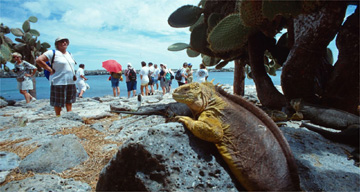The time has
come to face the final challenge in the UNIGIS Master program: the thesis.
Being an
ecologist, I wanted the work to take into account my interests, both personal
and professional. And, I am currently working on a project regarding the world-famous
Galapagos Islands in Ecuador, so I thought why not combine both. After some
research, I think I found my topic: Identifying terrestrial conservation
priorities in the Galapagos Islands, based primarily on anthropogenic threat assessment.
http://nothingtoloseandaworldtosee.files.wordpress.com
The conservation
of the famed Galapagos Islands experienced two crucial points during its
history: it started officially in 1959 with the creation of the Galapagos
National park, and was later expanded to the marine ecosystem by forming the
Galapagos Marine Reserve in 1996. However, by that time, the archipelago had
experienced severe human influence that first started with the discovery of the
Islands in 1535, intensifying strongly with the beginning of organized
colonization in 1983 and continuing relentlessly ever since. Today, the
Galapagos NP encompasses 96,7% of the islands (7 731 km2) and the Marine
Reserve reaches up to 40 miles from the Islands (138 000 km2), but anthropogenic
influence is still great and poses a significant threat to the conservation
efforts.
The primary
factor of influence is tourism, which has sky-rocketed in the last decades,
causing strong immigration of the Ecuadorean population from the continent,
bringing with it almost complete dependence of energy, food and water from the
continent, and causing a host of problems: introduced and invasive species,
illegal and uncontrolled fishing, contamination of aquifers and soil,
inadequate or (for the most part) inexistent solid waste and residual water
management, rampant urbanization, among others. These factors keep altering the
fragile ecosystems of the Galapagos Islands, despite the constitutional
protection that Pacha Mama (Mother Nature) enjoys in Ecuador and the continuous
efforts of the NP and Marine Reserve management.
http://static.guim.co.uk/sys-images/Travel/Pix/pictures/2006/04/19/galapagos360.jpg
Despite the
strong scientific interest in Galapagos, there have been few attempts to
quantify the anthropogenic influences suffered by the ecosystems. However, it
is precisely by means of a thorough evaluation of human risk factors risk that
conservation of the Islands should be managed, in order to aim its valuable and
costly efforts into particular human activities, specific areas and species.
The objective of
the project will be to perform an ecological risk assessment for terrestrial
conservation in the Galapagos Islands based on anthropogenic risk factors, and
identify areas that represent conservation priorities.
So… the next
step is to gather all the information available in order to identify, quantify
and spatially delimit the influences that the terrestrial ecosystems of
Galapagos face due to various human activities, and also to identify and
localize the distribution of target terrestrial species on the islands. With that,
it will be possible to identify areas that require particular conservation
efforts, based on an overlay of quantified threats and identified species, and
finally to produce a map of conservation priority areas.
So now cross my
fingers and start working…

